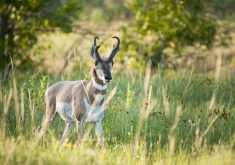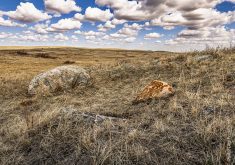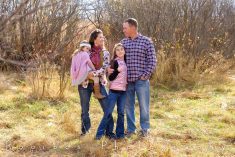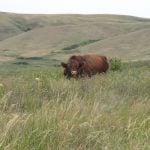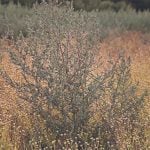The implications of a grass fire are rightfully terrifying in most situations. When it’s started purposefully, however, with meticulous planning and high safety standards, fire can act as a beneficial conservation and pasture management practice.
“I think we need to relook at how we perceive fire and look at fire not as a destructive force but as something that restarts the life cycle,” says Dinyar Minocher, interagency prescribed fire co-ordinator of the Canadian Prairies Prescribed Fire Exchange (CPPFE).
Read Also

Canadian Beef Check-Off Agency reports on investments and activities
The check-off agency’s work behind the scenes is what ensures cattle check-off dollars are invested wisely, accounted for transparently and deliver measurable value back to producers and importers.
Applying prescribed fire to a landscape requires careful risk management and considerable expertise. It can be difficult to find experienced fire managers to conduct these burns safely, among other challenges.
“Training up until this point is limited to public agencies. There are very unclear Canadian laws regarding liability, there’s a high cost associated with it, whether it be personnel or equipment,” says Minocher, speaking at a webinar hosted by the Saskatchewan Prairie Conservation Action Plan in November.
“One of the big goals of the Fire Exchange is to address these hurdles and acknowledge that as a team we’re capable of doing more than we are as individuals.”
The first group of its kind in Canada, the CPPFE is dedicated to expanding training opportunities and knowledge-sharing about prescribed fire as a management practice. Members of the organization include the Meewasin Valley Authority, Nature Conservancy of Canada, the University of Saskatchewan, Grasslands National Park, Canadian Wildlife Service, Manitoba Community Pastures, the city of Saskatoon and the Saskatchewan Ministry of Parks, Culture and Sport, all of which have an interest in prairie and parkland conservation.
The Canadian Prairies evolved with fire as a naturally occurring disturbance, but today this region experiences what is referred to as a fire deficit, Minocher explains.
“In the last 150 years since Europeans have moved across the Prairies, we’ve become very, very good at suppressing fire. But in this absence we see a lot of woody encroachment, forest encroachment; we’re losing the Prairies, the Prairies aren’t as healthy as they once were,” he says.
“Even in times of heavy suppression, fires don’t just disappear. In fact, when they come back, they come back so intensely with the amount of the fuel buildup that they’re harder and harder to control.”

The amount of fuel load on landscapes is becoming a greater issue, too. “We see an increase in fuel buildup, and as the fire seasons are getting longer, drier and hotter, we also see increased suppression costs and a need for more and more resources to take care of these problems,” he says.
The encroachment of invasive plant species only exacerbates the fuel load because they didn’t evolve with this ecosystem. “Now we’re seeing these invasive species that are really strong and resilient in the spring, they’re dying out in July, in August, right in the middle of our drought cycles, and so we’re seeing a heavy fuel buildup that previously wouldn’t have existed in seasons when the fire risk is highest.”
Prescribed fire can help remove these species from an area and reduce the fuel load, as well as allow for faster regrowth of vegetation due to nutrient cycling, making it more nutritious and attractive to grazers.
The CPPFE receives many questions about protecting wildlife during a prescribed fire, and Minocher points to the natural adaptations of animals when responding to fire, such as burrowing or moving to “the black,” which refers to areas already burned and considered safe.
“We also have control over when and where we’re lighting fire, so we know not to have prescribed fires in nesting bird seasons or in seasons that affect sensitive species.”
The benefits of prescribed fire to these ecosystems extend to the native wildlife species. “In the time since fire, the habitat goes through different successional stages, each of which has a unique vegetation composition structure, which support the varying needs of multiple species,” he says.
“By allowing for natural, low-intensity burns to happen regularly, we’ll have again that mosaic landscape that allows for addressing all the needs of all the different species that call the Prairies home.”
Careful planning, training and experience needed
It’s critical to remember that prescribed burns are complex and involve risk, and planning a fire is not to be taken lightly. Compared to the unpredictability of wild- fires, prescribed fire needs to be carefully controlled for the best outcome.
“Before we light a single match, before resources are even on site, we have a very good idea of the weather and fuel conditions that we need so that the fire can be safely contained and so we can reach our objectives,” says Minocher.
“We always have ample resources on site, we have contingency plans, there are fireguards put in place and the prescription that we write ahead of time (ensures) that we know exactly what wind direction we need, what speed we need, what fuel condition we need, and with that we know when it’s safe to light.”

The objective of the fire determines all the factors involved, says Minocher, who referenced an example from a Kansas prescribed fire agency of pasture burns to stimulate forage production. “For that, they would be looking for a lower intensity fire, they’d want it in the spring, they want to do it every year, and they just need the fire to be hot enough to consume everything on the surface level,” he explains.
“They take into consideration other things like topography — fire burns faster going uphill — different levels of buildup where they’re going to see hotter fire activity, fuel moisture, aspect — a south-facing hill is going to burn hotter because it’s going to be drier, whereas a north-facing hill didn’t get as much sun — and also things like smoke management for cities.”
In the Canadian Prairies, the objective of most prescribed fires is to control the loss of pasture due to brush encroachment. In this case, a hotter fire with higher intensity would be required, and to do so conditions would need to be drier, so late fall may be the target timing. It may also be necessary to schedule a series of fires over several years to effectively deal with the encroaching brush.
“Knowing what you need of the fire, you’re able to write the prescription and understand what conditions would be sufficient for both achieving your objective, but also doing it in a way that’s safe and manageable and that you’re going to be able to contain it within the parameters of the fire.”
For example, choosing the precise weather conditions is one of several major considerations. “It’s not enough to just write a fire prescription and know what time of year. We’re constantly waiting for the perfect weather window, we know what we’re looking for, and sometimes it takes a few years to hit the window sufficient to carry out a full burn,” he says.
Other key factors include knowing the fuel load amount and exactly the kind of vegetation in the area you want to burn, as different types of grass burn differently. “Given the species, given the day, everything can change,” he continues. “It’s important that everyone is familiar with the site and everything that you’re hoping to burn.”
The high level of knowledge and experience required to safely and successfully conduct prescribed fires is what CPPFE is working to foster through its three branches. The first branch is assistance with planning and co-ordination.
“We recognize that resources, personnel and equipment sharing is very expensive and is an obstacle to prescribed fire, and so we’ve established a cache that we’re happy to share,” says Minocher. “We’re creating mutual aid agreements so lots of different agencies and landowners are able to help each other out, and also we co-ordinate personnel.”

The second branch of CPPFE’s activities is focused on training, which includes workshops, webinars and practical training opportunities. The group developed a new course, Introduction to Prescribed Fire in the Grassland Environment, which is open to anyone interested in learning more and will be hosted online by the University of Saskatchewan starting in February 2022.
“That exists not as a certification to go and do it, but as the first step into exploring what it would take, and then from there we encourage you to attend training events or workshops where we’ll work with partners that have a lot of experience,” he says.
For example, the Meewasin Valley Authority’s “resource conservation team put in a lot of work to develop a lot of training plots, smaller plots with fire breaks that we were then able to invite partners to come and burn and learn and just build their own capacity, understanding and experience,” he says.
The third branch is creating a database for research on grassland fire and prescribed burns, in which they are collaborating with a few Canadian universities.
Groups interested in hosting a prescribed fire workshop can contact the Canadian Prairies Prescribed Fire Exchange through its website, grasslandfire.ca.




